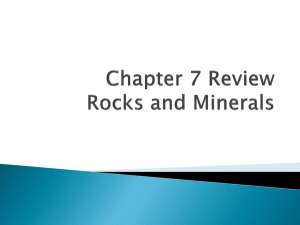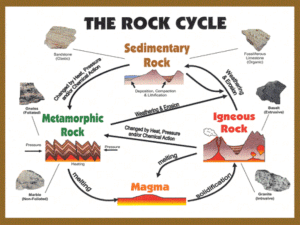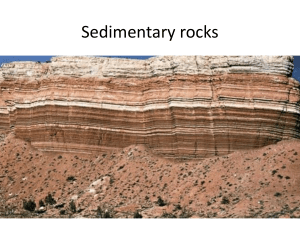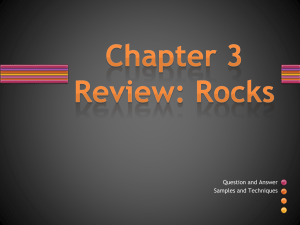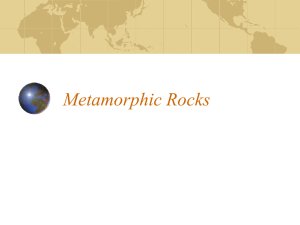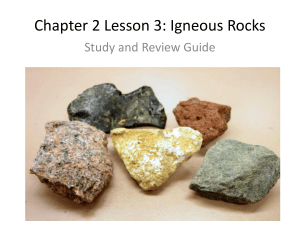here - Earth Science
advertisement
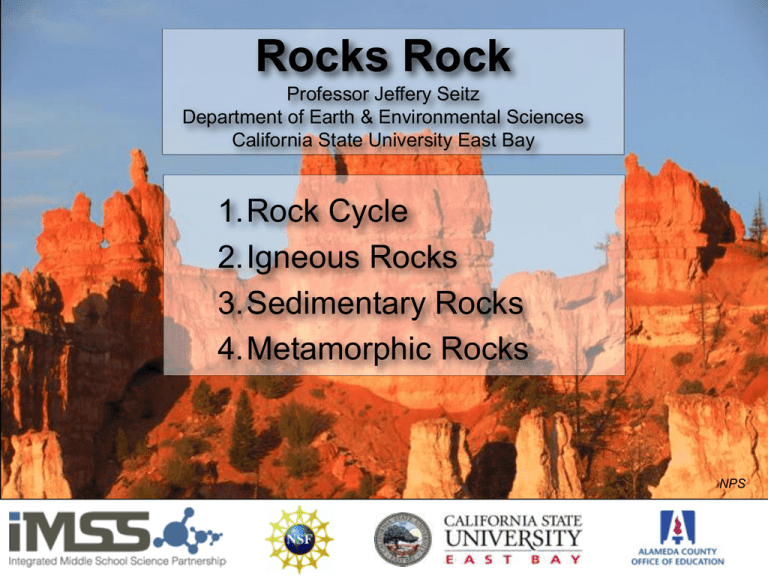
Rocks Rock Professor Jeffery Seitz Department of Earth & Environmental Sciences California State University East Bay 1. Rock Cycle 2. Igneous Rocks 3. Sedimentary Rocks 4. Metamorphic Rocks NPS 1 Why are minerals & rocks important? Geologic processes depend upon geologic materials •volcanic eruptions • earthquakes • landslides • erosion • mountain building A basic knowledge of Earth materials is essential to understanding geologic processes. DEFINITIONS A rock is any solid mass of mineral (or mineral-like) matter that occurs naturally. A few rocks may be composed of only one mineral, but most are an aggregate of several minerals. A mineral is any naturally occurring inorganic solid that possesses an orderly internal structure and a definite chemical composition. • •• •• naturally occurring (concrete, synthetic diamonds, etc. are excluded). inorganic (teeth, seashells, trees, etc. are excluded) solid (gases and liquids are excluded) orderly structure (crystalline structure) definite internal chemical composition One way that rocks are characterized is by their mineral content. For example, the rock granite commonly contains the three minerals: •quartz •feldspar •biotite Luckily, most rocks are composed of a few common rockforming minerals. quartz feldspar biotite 1. The Rock Cycle Three basic rock types: igneous - form from molten rock - magma/lava sedimentary - form from sediment and chemical precipitation in seawater metamorphic - form from other rocks that recrystallize (solid state) under higher pressures and/or temperatures. The Rock Cycle Let’s consider the different processes that would alter and transform rocks Igneous Processes Sedimentary Processes Metamorphic Processes melting & crystallization weathering (& erosion) burial (heat & pressure) This rock cycle diagram correlates changes to larger scale processes such as uplift. In addition, this rock cycle diagram treats sediment and melt (magma or lava) as intermediate materials in the cycle. 2. Igneous Rocks The word igneous comes from the latin word ignis which means fire. Magma is completely or partly molten material. USGS Magma that reaches the surface is known as lava. Once the magma has formed, it is less dense than the surrounding rocks and rises buoyantly towards the Earth's surface. If the magma makes it to the Earth's surface, it may produce a spectacular volcanic eruption. Igneous rocks that solidify at the surface are classified as extrusive or volcanic. If the magma crystallized before it reaches the surface, it is classified as intrusive or plutonic. Classification of Igneous Rocks The classification of igneous rocks is based upon: 1. Composition (chemical and/or mineralogical) - the chemical composition of an igneous rock will be expressed by its mineralogy (i.e., what minerals are present). 2. Texture - describes the overall appearance of an igneous rock based on the size, shape and arrangement of its interlocking crystals. Igneous Compositions Igneous rocks are mainly composed of silicate minerals. The silicate minerals that form in a rock is primarily determined by the bulk chemical composition of the magma from which the rock crystallized. Two major groups of silicate minerals: •dark ferromagnesian minerals containing more Ca, Fe, Mg (olivine, pyroxene, amphibole, biotite) - mafic •light minerals containing more silica, Na, K (feldspars, quartz, muscovite) - felsic An igneous rock can be composed predominantly of dark or light silicate minerals — or various combinations of different minerals. Composition of two familiar rocks: granite is felsic and composed predominantly of light-colored minerals such as feldspar, quartz, (and dark biotite) basalt is mafic and composed predominantly of dark silicates such as pyroxene, olivine (and feldspar) Igneous Textures The most important factor that contributes to the texture of an igneous rock is the cooling rate. USGS In a lava flow (extrusive/volcanic), the lava cools quickly which results in the formation of smaller crystals. Instantaneous cooling may result in the formation of glass (disordered solid). A large igneous intrusive (plutonic) body located at depth may cool over a period of tens or hundreds of thousands of years. This slow cooling rate promotes the formation of larger crystals. granite Igneous Textures The cooling rate of magma or lava results in a number of specific igneous textures. Phaneritic texture results from slow cooling (plutonic) and is where all of the crystals in the rock are large enough to be seen with the naked eye. rhyolite Aphanitic texture results from rapid cooling (volcanic) and is where the crystals are generally too small to be seen with the naked eye. Glassy texture results from instantaneous cooling (volcanic) where glass forms rather than crystals. obsidian Note that the Greek root “phan” means to show. 13 Igneous Textures More complex cooling of magma and lava may result in two or more distinct sizes of crystals called porphyritic texture. The large larger crystals are known as phenocrysts. The population of small crystals is known as the groundmass. Porphyritic aphanitic texture is consists of visible phenocrysts and a groundmass with crystals that are two small to see with the naked eye (aphanitic). Porphyritic phaneritic texture consists of phenocrysts surrounded by a groundmass composed of crystals that are large enough to see with the naked eye (phaneritic). 14 ⬅ Igneous Chemistry ➡ Common Igneous Rocks Felsic - poor in Fe and Mg, rich in silica Intermediate between felsic and mafic Mafic - rich in Fe and Mg, poor in silica Ultramafic - very rich in Fe and Mg, poor in silica ⬅ Igneous Texture ➡ Plutonic Volcanic granite rhyolite diorite andesite gabbro basalt peridotite (komatiite) 15 Igneous Rock Mineralogy Mineralogical Society of America 16 Igneous Rocks — Gabbro Gabbro is an intrusive/plutonic igneous rock that contains crystals that are large enough to see with the naked eye indicating that it formed from slow cooling. Its dark color indicates that it formed from Fe- and Mgrich (mafic) magma deep within the Earth. It is composed of mostly dark minerals including a dark variety of feldspar. Igneous Rocks — Basalt Basalt is a volcanic igneous rock and has the same composition as gabbro. Since it is volcanic, it cooled much more rapidly and formed smaller crystals (generally aphanitic or very finely phaneritic in texture). The seafloor is made of basalt and thus, it is the most common igneous rock on the Earths surface! Basalt is the volcanic analog to gabbro. Basalt is the most common volcanic rock on Earth and comes in a large number of varieties. Basalt may erupt as a very fluid lava and form lava flows with fluid features. This type of basalt is known as pahoehoe. AGU As basalt cools while flowing on the surface, it may become more viscous forming solid “chunks” - this type of basalt is known as aa. USGS Basalt commonly contains holes where gas bubbles escaped during the cooling and crystallization of the basalt. This variety of basalt is known as vesicular basalt or scoria basalt. Igneous Rocks — Granite Granite is an intrusive/plutonic igneous rock that contains crystals that are large enough to see with the naked eye indicating that it formed from slow cooling. It is composed of predominantly lightcolored minerals such as quartz and feldspar (felsic composition) and commonly contains a dark mineral such as biotite or hornblende. Encyclopedia of Science The color of granite ranges from pink to white (depending on the composition of the feldspar crystals). Granite is similar to the average composition to the Earth’s continental crust. Igneous Rocks — Rhyolite Rhyolite is a volcanic (fine-grain) igneous rock with a composition similar to granite (felsic). Since it is volcanic, it cooled much more rapidly than granite and formed smaller crystals (generally aphanitic or very finely phaneritic in texture). It is usually buff, pink or gray in color. Rhyolite is the volcanic analog to granite. Igneous Rocks — Obsidian Obsidian forms from the instantaneous quenching of a granitic (felsic) lava to form volcanic glass. Although obsidian is commonly black, its chemical composition is more like that of granite (not basalt). The black color comes from tiny iron oxide crystals in the glassy matrix. Igneous Rocks — Pumice Pumice also forms from the instantaneous quenching of a granitic lava - very similar to obsidian. However, it is frothy because it contained a lot of dissolved gases that escaped during quenching. Pumice is frothed-up glass and thus has a very low density - some samples float in water! Connection to Plate Tectonics and Volcanism Origin of Seafloor Basalt The seafloor is formed at midocean ridges and is composed predominantly of basalt. The source of the basaltic magma is the upper mantle formed by the partial melting of the mantle from decompression. The mantle is composed predominantly of ultramafic rocks and experimental studies show that when mantle rocks melt, they form a molten liquid that is basalt (mafic) in composition. 24 Connection to Plate Tectonics and Volcanism Origin of Intermediate Volcanics at Subduction Zones At a subduction zone, magma is generated from partial melting of the upper mantle just above the subducted plate. Melting occurs because water is driven off of the subducted plate into the mantle above (water lowers the melting temperature). The magma that is generated is basaltic (mafic) in composition. However, the arc volcanics are intermediate (andesite) in composition. How can the composition of the magma change from basalt to andesite? 25 Connection to Plate Tectonics and Volcanism Origin of Intermediate Volcanics at Subduction Zones The Bowen’s Reaction Series shows how magma may change composition by progressive crystallization from mafic to intermediate to felsic. Wikipedia contributor: Colivine This process is known as igneous differentiation. As a mafic magma crystallizes, the first minerals that appear are rich in Mg, Fe and Ca and poor in silica. As the crystals separate from the magma, the magma is then relatively enriched in silica and depleted in Mg, Fe and Ca. 26 Connection to Plate Tectonics and Volcanism Origin of Intermediate Volcanics at Subduction Zones As the mafic magma that is formed in the upper mantle ascends through the lithosphere (buoyantly), it begins to crystallize and its composition changes to become intermediate. In addition, if the magma ascends through continental crust, it will begin to assimilate the felsic crustal rocks forcing the magma to become even more intermediate. 27 Connection to Plate Tectonics and Volcanism Growth of Continental Crust Processes such as igneous differentiation (and volcanism related to subduction) result in the production of low density intermediate and felsic rocks that may form continental crust. Rock Density (g/cm3) Granite (cont. crust) 2.6 - 2.7 Shale 2.4 - 2.8 Basalt (ocean crust) 2.8 - 3.0 Peridotite (mantle) 3.1 - 3.4 Intermediate to felsic igneous rocks and marine sediments such as shale have densities that are too low to be subducted under basaltic ocean crust. 28 Connection to Plate Tectonics and Volcanism Growth of Continental Crust Exotic terranes may be added to the edge of a continent when the basaltic ocean floor is subducted along a continental margin. geologycafe.com 29 Connection to Plate Tectonics and Volcanism Growth of Continental Crust This map shows the core of the ancient North American continent (known as a craton) that formed about 1 1.5 billion years ago (brown). In addition, terranes that have been added to the western margin of North America in the last 600 million years (green). NPS 30 3. Sedimentary Rocks The Earth’s surface is a very dynamic environment! Volcanic and other mountain building processes elevate portions of the Earth's surface, while opposing forces move material from high elevation to lower elevation. Weathering is the physical breakdown and chemical alteration of rocks at or near the Earth's surface. Physical processes include changes in temperature and biologic activity. Erosion is the physical removal of material by mobile agents such as water, wind or ice. Sedimentary Rocks Mechanical and chemical weathering produce the raw materials for sedimentary rocks. Sedimentary rocks only comprise ~5% of the Earth's crust — however, they are much more important than this percentage would imply. Sedimentary rocks occur in the portion of Earth where we live. Important source of resources: energy (coal, petroleum) water (storage of groundwater) minerals (gold, aluminum, lead/zinc,etc) Types of Sedimentary Rocks Weathering results in two types of products: 1. solid particles (sand grains, clay minerals, etc.) 2. dissolved constituents in water This results in two fundamentally different types of sedimentary rocks: 1. detrital (clastic) sedimentary rocks formed from transported solid particles (detritus or clasts). 2. chemical sedimentary rocks - formed river rocks by the precipitation of dissolved substances by either inorganic or biologic processes salt flat Detrital Sedimentary Rocks Quartz and clay minerals are the dominant constituents of detrital sedimentary rocks. quartz - very resistant to weathering. clay - product of chemical weathering of silicate minerals - very stable at the Earth’s surface. Feldspars, micas and other silicate minerals may occur in sedimentary rocks. Since these minerals are subject to chemical weathering (chemically unstable), their presence indicates that the sediment did not travel far. Detrital Sedimentary Rocks Sedimentary rocks are classified on the basis of particle size, shape and composition. Sizes of particles can provide useful information about the environment of deposition: • Gravels are found in high energy environments such as mountain streams and some beaches. • Sands are found in intermediate energy environments such as beaches and river deposits. • Clays are found in quiet environments such as lakes and the deep ocean. Particle Size Classification for Detrital Sedimentary Rocks Size Range (mm) Particle Name Sediment Name Rock Name >256 64 - 256 4 - 64 2-4 Boulder Cobble Pebble Granule Gravel Conglomerate or Breccia 1/16 - 2 Sand Sand Sandstone 1/256 - 1/16 <1/256 Silt Clay Mud Shale or Mudstone Shale is a fine grained detrital sedimentary rock composed of silt- and clay-sized particles (too small to see with the naked eye) and forms in quiet (low energy) aqueous environments. Alignment of the plate-like clay particles permits shale to be split into layers. Mudstone is similar to shale but does not split into layers. Fossils are common in shale - the quiet depositional environment aids in the preservation of organisms. Geological Society of London Detrital Sedimentary Rocks - Shale Shale is the most common sedimentary rock and is forming in ocean basins and is found on continents in ancient sedimentary basins. Shale is becoming an important source of oil and natural gas with the development of hydraulic fracturing technologies to extract the energy resources. iStockphoto / Edward Todd 38 Detrital Sedimentary Rocks — Sandstone Sandstones are detrital rocks containing sand-sized particles that form in moderate energy environments. Quartz is the dominant mineral in sandstone - due to its durability. A well-sorted pure quartz sandstone with rounded grains indicates that it may be the result of a great deal of transport - maybe over several cycles. •Pure quartz sand indicates a distant source for the sediment - other minerals are unstable and weather away. •Sands containing other minerals indicate that they were deposited near the source of the sediment - minerals other than quartz (such as feldspars and hornblende) indicate are unstable in the sedimentary environment. Detrital Sedimentary Rocks - Conglomerate and Breccia These rocks consist of dominantly gravel-sized particles that form in high energy environments. The particles are large enough to be identified as distinctive rock types which may indicate the source of sediment. These are usually contain mud and sand as a matrix between the large particles. Conglomerate - composed of rounded particles indicating some degree of transport (mountain stream, beaches). Breccia - composed of angular fragments indicating that they did not travel far from their source (landslide, explosive hydrothermal activity, fault zones). Chemical Sedimentary Rocks Chemical sedimentary rocks are derived from material that is carried in solution to lakes and seas. Precipitation occurs in two ways: 1. Inorganic processes such as evaporation can produce chemical sediments. (ex. evaporites, dripstone, travertine, etc.) 2. Biologic processes (forming shells) results in chemical sediment. Organisms die and collect on the seafloor (ex. coral, chalk, etc.). Chemical Sedimentary Rocks — Limestone Limestone is a very diverse rock and has a very wide range of occurrences ranging from coral reefs to chalk to cave formations Some limestones straddle the line between detrital and chemical sedimentary rocks. Many contain detrital and biogenic (shell) particles as well as being the product of precipitation from seawater. Limestone commonly contains fossils of marine organisms. MO Dept. of Natural Resources Limestone is the most common chemical sedimentary rock & is composed chiefly of the mineral calcite (reacts to acid). Lithification Lithification is the process by which unconsolidated sediment is transformed into solid sedimentary rock. Two process are important in lithification: 1. compaction — as sediments accumulate through time, the weight of overlying material compresses/compacts the deeper sediment. 2. cementation — cementing materials are carried in solution by water percolating through the pore spaces between particles. Calcite, silica, and hematite are common cementing agents. The photo shows a sandstone with quartz (Q) grains cemented by calcite (C) in thin section. Features of Sedimentary Rocks Sediments display a variety of different structures that allow us to determine some of the environmental parameters in a depositional environment. The photo to the right shows crossbedding which is characteristic of sand dunes, deltas, etc. NPS NPS Fossils are common in sedimentary rocks and provide a record of the environment/ecosyste m. Sedimentary Structures Ripple marks are small waves of sand that develop on a surface and may be preserved in a sedimentary rock during lithification. Mud cracks indicates that sediments went through cycles of wet and dry. They may be preserved in the sedimentary rock. Depositional Environment and Facies Sedimentary rocks indicate the type of environment in which they formed. For example, the Paleozoic sediments in the Grand Canyon range from shales to sandstones to limestones. Thus, we can use the type of sedimentary rock to infer how the depositional environment changed with time. NPS Depositional Environment and Facies In addition, different sedimentary environments occur over a broad area at the same time. The term facies is used to describe these sets of sedimentary rocks that grade from one into another. For example, sand and conglomerate may accumulate in a beach environment (high energy) while finer muds are deposited in quieter offshore waters. In even deeper water, calcareous (limestone) sediments may accumulate where land-derived sediments are scarce. Different sediments are accumulating adjacent to one another at the same time. 47 4. Metamorphic Rocks Metamorphic rocks form as igneous, sedimentary or even other metamorphic rocks are changed due to an increase in temperature and/or pressure. The increase in pressure and temperature usually occurs as the rock is buried deeper in the Earth. Temperature increases in the crust ~20-30°/km (geothermal gradient) Pressure increases with depth ~280 bar/km (geobaric gradient) Metamorphism occurs incrementally, from slight change (known as low-grade metamorphism) to dramatic change (high-grade metamorphism) from the parent rock. Metamorphic rocks change without melting (solid state reactions). The parent rock is the original rock before metamorphism. Metamorphism causes changes in rocks, including increased density, growth of larger crystals, reorientation of grains into layers or bands, and the formation of new minerals. These changes may be grouped into two broad categories: 1. textural changes 2. mineralogic changes (composition) In addition, on a larger scale, the forces that cause metamorphism may also deform (fold and shear) rocks. The most common geologic settings for metamorphism are: 1. Contact (thermal) metamorphism occur in rocks when they are intruded by hot magma - "bake" the surrounding rock- it is a relatively small event. 2. Regional metamorphism occurs when large-scale deformation occurs in rocks when they are subjected to higher pressure and temperatures during "mountain building" processes. Pearson Textural Changes in Metamorphic Rocks During metamorphism, rocks may develop foliation where mineral grains realign and recrystallize (solid state) perpendicular to stress. The development of foliation is common during regional Uniform Pressure Differential Stress metamorphism where stress is greater in one direction than in the others. Some metamorphic rocks are nonfoliated - they do not develop a parallel alignment of mineral grains. Nonfoliated rocks are common with contact metamorphism where rocks are heated by an igneous magma but are not subjected to high increases in pressure. Let’s consider the progressive metamorphism of a shale (or mudstone) during a regional metamorphic event (mountain building). Shale Remember that shale is a fine grained detrital sedimentary rock composed of silt- and clay-sized particles (too small to see with the naked eye) and is the most common sedimentary rock. Progressive metamorphism: slate ➞ phyllite ➞ schist ➞ gneiss Progressive metamorphism generally results in rocks that are 52 increasingly coarse in texture (larger crystals). WHOI Common Metamorphic Rocks: Foliated Rocks Common Metamorphic Rocks: Foliated Rocks Slate is the first distinctive metamorphic rock to form. It is low-grade (relatively low pressure and temperature), very fine grained foliated rock composed of microscopic grains of mica. Slate has excellent rock cleavage. The foliation in slate is not related to the foliation in shale. The foliation in slate forms perpendicular to the greatest stress. 53 Common Metamorphic Rocks: Foliated Rocks Low to moderate-grade metamorphism of shale results in phyllite. Phyllite is a foliated metamorphic rock that is similar to slate. In phyllite, the mica crystals (although generally too small to see with the naked eye) are large enough to give phyllite sheen (reflects light). Progressive metamorphism: slate ➞ phyllite ➞ schist ➞ gneiss 54 Common Metamorphic Rocks: Foliated Rocks The next step in the progressive metamorphism of shale is schist. Schist is a moderate- to highgrade foliated rock where the platy minerals (micas) (>50%) are large enough to see with the naked eye. Phyllite may contain larger accessory minerals such as garnet. Progressive metamorphism: slate ➞ phyllite ➞ schist ➞ gneiss 55 Common Metamorphic Rocks: Foliated Rocks Gneiss high-grade foliated metamorphic rock where the minerals have segregated into bands of light and dark minerals (gneissic banding). Gneiss may or may not possess rock cleavage. It is common to find folds in the bands of minerals in gneiss. Progressive metamorphism: slate ➞ phyllite ➞ schist ➞ gneiss 56 Nonfoliated Textures Nonfoliated metamorphic rocks typically form in contact metamorphic environments. Not all metamorphic rocks will developed foliated texture due to the absence of platy minerals. However, the size of the crystals increases with increased metamorphic grade. Marble is a nonfoliated metamorphic rock that is commonly composed of the mineral calcite (reacts to acid). The parent rock of marble is limestone. Marble is commonly used as a decorative stone. 57 Nonfoliated Textures Quartzite is a nonfoliated metamorphic rock that is composed of quartz. The parent rock of quartzite is sandstone. It is very hard and chemically resistant. Quartzite may appear to look similar to marble but can be by its extreme hardness since it is composed of fused quartz grains. In addition, marble will commonly react with acid. Common Metamorphic Rocks Rock Name Slate Phyllite Schist g r a d e Texture f o l i a t e d Gneiss Quartzite Marble nonfoliated Grain Size Comments Parent Rock Very fine Rock cleavage Shale or mudstone Fine Wavy rock cleavage; glossy Slate Medium to Coarse Mica minerals & scaly foliation Phyllite Medium to Coarse Banding Schist Medium to Coarse Massive & very hard Quartz sandstone Fine to Medium Granular Limestone 59
